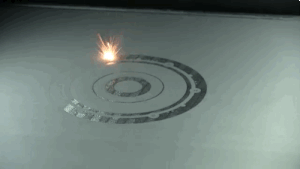GE just 3D printed a jet engine—complete and functioning. It’s a pretty cool trick. The engine, about the size of a football, is a much-simplified version of something you might see on a commercial jet. But as we can’t fully 3D print one of those yet, this simpler design is used on RC planes instead of 747s.
GE is one of several aerospace players experimenting with industrial 3D printing. They’ve been using the tech to make finished parts for real jet engines too. Last year, for example, they said their CFM Leap engine would use 3D printed nozzles. Others, like SpaceX, are likewise using 3D printed parts in their creations.
The team—comprised of engineers, technicians, and machinists at GE Aviation—have been working on the engine for a few years. It started as a fun side project and, at the same time, an experiment to see just what the tech could do. Aiming to build a working engine consisting of 3D printed parts, they found plans for something simpler than a commercial aircraft engine and modified the design for 3D printing.
The engine wasn’t printed as one piece. Rather, it was printed piecemeal and assembled. Even so, it’s indicative of a larger trend. Industrial 3D printing is moving from prototyping to manufacturing.
 Whereas additive techniques have been used to prototype parts for decades, the latest tech can now print finished products. GE (and others) 3D print robust metal parts with a computer-guided laser. The laser melts successive layers of metal powder, building up the desired shape. After printing, the engineers finish and assemble their creations.
Whereas additive techniques have been used to prototype parts for decades, the latest tech can now print finished products. GE (and others) 3D print robust metal parts with a computer-guided laser. The laser melts successive layers of metal powder, building up the desired shape. After printing, the engineers finish and assemble their creations.
“There are really a lot of benefits to building things through additive,” says Matt Benvie, spokesman for GE Aviation. “You get speed because there’s less need for tooling and you go right from a model or idea to making a part. You can also get geometries that just can’t be made any other way.”
GE’s Angel Trumpet isn’t, strictly speaking, the first 3D printed jet engine we’ve seen.
Earlier this year, researchers from Australia’s Monash University showed off an engine of their own. To build it, the team disassembled a small auxiliary engine used in business jets and scanned the parts. They then 3D printed and reassembled the engine. They hope to have a working version in two years. (Which hints at when we may move beyond a simple working engine like GE’s to something more complex.)
Xinhua Wu, who led the project, explained the allure of 3D printed jet engines. Due to their complexity, she said, jet engine components can take anywhere from 6 to 24 months to manufacture. But with 3D printing, the manufacturing time can be cut down to something like one to two weeks.
“Simple or complex, 3D printing doesn’t care,” she said, “It produces [parts] in the same time.”
It’s early days, but the number of finished 3D printed components, especially in aerospace, is rising. And while these examples mimic traditional designs, future engines may be designed specifically for 3D printers, including parts that can’t be made any other way, or reducing the total number of parts used.
Combined with other tech, like computerized subtractive CNC machines, Andre Wegner tidily summed up the future of manufacturing to me like this recently: We’re closing in on the “factory in a box.”
Image Credit: GE Aviation



